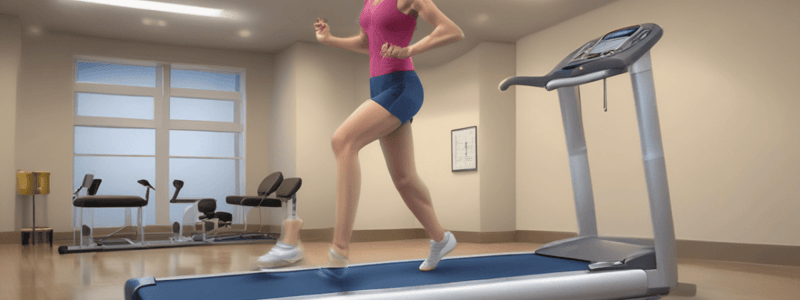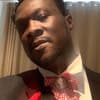Podcast
Questions and Answers
What is the main purpose of assessing functional skills in patients with balance disorders?
What is the main purpose of assessing functional skills in patients with balance disorders?
- To diagnose the patient's fall risk in extreme weather conditions
- To evaluate the movement quality
- To assess the patient's ability to perform high-level athletic activities
- To identify underlying motor, sensory, and cognitive impairments (correct)
Which of the following tests is commonly used to assess balance ability in patients?
Which of the following tests is commonly used to assess balance ability in patients?
- Gaithersburg Diagnostic Test
- Balance Ability Self-Assessment (correct)
- Washington Balance Scale
- Romberg Test
What is the primary focus of the Berg Balance Test?
What is the primary focus of the Berg Balance Test?
- Measuring muscle strength in elderly patients
- Evaluating cognitive function in patients with dementia
- Determining visual acuity in patients with eye problems
- Assessing balance in neurological patients (correct)
What is the interpretation of a score between 21-40 on the Berg Balance Test?
What is the interpretation of a score between 21-40 on the Berg Balance Test?
What is the primary focus of motor strategies in evaluating equilibrium?
What is the primary focus of motor strategies in evaluating equilibrium?
What is the purpose of the Romberg Test?
What is the purpose of the Romberg Test?
What is the primary focus of visual strategies in evaluating equilibrium?
What is the primary focus of visual strategies in evaluating equilibrium?
What is the primary focus of gait assessment in patients with balance disorders?
What is the primary focus of gait assessment in patients with balance disorders?
What is the significance of assessing gait in patients with balance disorders?
What is the significance of assessing gait in patients with balance disorders?
What is the purpose of the Activities-Specific Balance Confidence (ABC) Scale?
What is the purpose of the Activities-Specific Balance Confidence (ABC) Scale?
What is the ultimate goal of a functional assessment tool in gait analysis?
What is the ultimate goal of a functional assessment tool in gait analysis?
What are the three aspects that a functional test must take into account?
What are the three aspects that a functional test must take into account?
What is the normal speed of an adult on flat ground?
What is the normal speed of an adult on flat ground?
Which of the following is NOT a tool used for monitorizing?
Which of the following is NOT a tool used for monitorizing?
What is the purpose of the Rivermead Visual Gait Assessment (RVGA)?
What is the purpose of the Rivermead Visual Gait Assessment (RVGA)?
What is a limitation of traditional scales used in gait assessment?
What is a limitation of traditional scales used in gait assessment?
What may occur when an individual factor is altered?
What may occur when an individual factor is altered?
What is the purpose of the Gillette Functional Assessment Questionnaire?
What is the purpose of the Gillette Functional Assessment Questionnaire?
Why may a physical therapist need to adopt a flexible position?
Why may a physical therapist need to adopt a flexible position?
What type of scales are required for community living?
What type of scales are required for community living?
What is the primary function of balance in the human body?
What is the primary function of balance in the human body?
What are the three major afferent systems involved in balance?
What are the three major afferent systems involved in balance?
What is the role of the cerebellum in balance?
What is the role of the cerebellum in balance?
What is the difference between static and dynamic balance?
What is the difference between static and dynamic balance?
What is a direct way to cause balance disorders?
What is a direct way to cause balance disorders?
What is the purpose of functional assessment tools in balance assessment?
What is the purpose of functional assessment tools in balance assessment?
What are the three aspects that a functional test must take into account in balance assessment?
What are the three aspects that a functional test must take into account in balance assessment?
Why is it mandatory to preserve the patient's integrity during balance assessment?
Why is it mandatory to preserve the patient's integrity during balance assessment?
How many tests should be used in balance assessment to provide comprehensive information?
How many tests should be used in balance assessment to provide comprehensive information?
What is the consequence of deafferentation on balance?
What is the consequence of deafferentation on balance?
Flashcards are hidden until you start studying
Study Notes
Balance Assessment
- Balance is the ability to maintain positions and move, adapting to intrinsic and extrinsic changes in posture under the influence of gravity.
- The three major afferent systems that contribute to balance are:
- Visual
- Vestibular
- Somatosensory
- Stability involves processing afferent and efferent information, resisting and anticipating disturbances, and maintaining a stable static position while allowing movement.
Balance Disorders
- Direct way: injury to major afferent systems and integrative system (e.g., deafferentation, damage to sensors or nerves, alteration of CNS).
- Indirect way: impairment of nerve signal transduction (e.g., bony-joint trauma, prolonged immobilization).
Balance Assessment Tools
- Functional assessment tools (tests or scales) to define deficits, establish a treatment plan, and achieve patient functional independence.
- Functional tests must consider three aspects: functional skills, motor and sensory strategies, and sensory, motor, and cognitive deficiencies.
- Examples of commonly used tests:
- Balance ability Self assessment
- Activities-specific Balance Confidence (ABC) Scale
- Falls Efficacy Scale-International (FES-I)
- Berg Balance test (assesses balance in elderly and neurological patients)
Berg Balance Test
- Measures balance in elderly and neurological patients
- Consists of an assessment of functional tasks
- 14-item scale
- Equipment: ruler, 2 chairs, stool, stopwatch
- Time: 15-20 minutes
- Scoring: 0-56 points
- Interpretation:
- 41-46: low fall risk
- 21-40: medium fall risk
- 0-20: high fall risk
Evaluation of Equilibrium Strategies
- Motor strategies:
- Alignment (sitting and standing position)
- Movement strategies (patient ability to maintain postural control)
- Sensitive strategies:
- Romberg Test
- Dynamic posturography
- Sensory Organization Test (SOT)
- Visual strategies:
- Ability to organize and select sensory information in response to changing visual conditions
Gait Assessment
- Gait is a neuromuscular and musculoskeletal action of the whole body that requires coordination of both legs and multiple joints and muscles.
- Functional assessment tools to define deficits, establish a treatment plan, and achieve patient functional independence.
- Functional tests must consider three aspects: functional skills, motor and sensory strategies, and sensory, motor, and cognitive deficiencies.
Gait Assessment Tools
- Cadence: 111-117 steps/min
- Speed: 82 m/min (adult, normal speed on flat ground)
- Monitoring tools:
- Stopwatch
- Podometer
- Step watch activity monitor
- Examples of commonly used tests:
- Hoffer Functional Ambulation Scale
- Figure of 8 walk test
- Gillette Functional Assessment Questionnaire
Evaluation of Gait Strategies
- Functional Ambulation Classification
- Ranches Los Amigos Walking Ability Questionnaire (RLAH)
- Rivermead Visual Gait Assessment (RVGA)
- Motor Assessment Scale
Scales Limitations
- Mobility, balance, or general motor control does not provide information about the way in which the activity occurs.
- These measures do not delve into the underlying deficits that require treatment.
- Scales covering a wider range of gait abilities, especially in community living, are required.
Studying That Suits You
Use AI to generate personalized quizzes and flashcards to suit your learning preferences.





